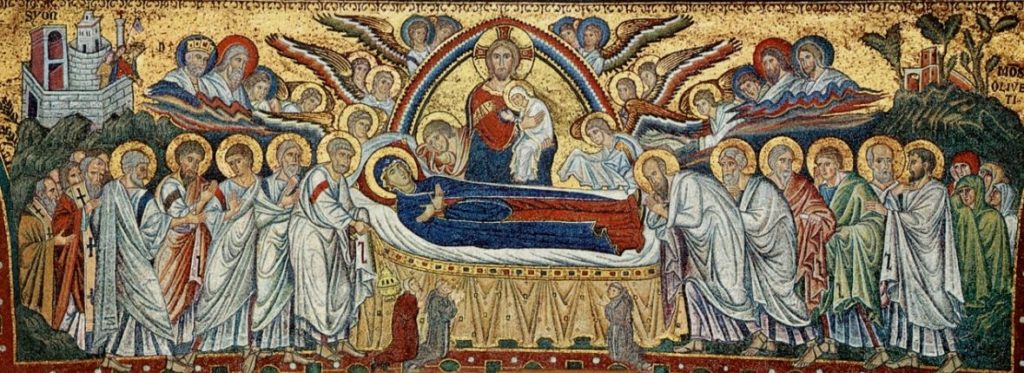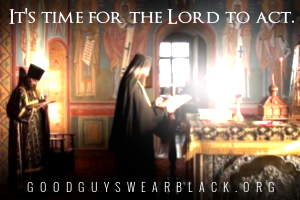
Sermon by Fr. Matthew Baker
Notes for a sermon delivered during Great Vespers, Dormition of the Theotokos, 2014
Today we celebrate a great and joyous solemnity: the falling asleep of the Mother of God in Jerusalem, and her bodily translation into glory.
“The Whole Mystery of the Economy”
The readings this evening – from Genesis, Ezekial, and Proverbs – present us with a series of images, all with reference to the Theotokos. She is the ladder ascending from earth to heaven, beheld by the patriarch Jacob in a vision (Gen. 28:12). She is Beth-el, God’s house, and the gate of heaven (Gen. 28:17). She is the east gate of the Temple sanctuary, which remains shut – virginal: no man enters,
“for the Lord, the God of Israel, has entered through it,”
as Ezekial prophesies (Ez. 44:2). She is wisdom, or the house of wisdom, of which king Solomon speaks (Prov. 9:1).
These readings– from Genesis, Ezekial, and Proverbs – represent the 3 divisions of the Jewish Bible: the Torah, the Prophets, and the Writings. Together they comprise a “bouquet” representing the whole of what we call the Old Covenant. It is as if to say: Mary is the sum towards which the whole history of Israel was pointing all along. She is the daughter of Zion, the hinge of salvation history.
In her is the beginning of the New Covenant.
In the words of St John of Damascus,
“in the name Theotokos is contained the whole mystery of the economy.”
Economy – oikonomia, as we often hear in our hymns – refers to God’s ordering of his “household,” his governance of creation and history according to his plan for our salvation and glorification. There is an order to God’s plan, and a unity of meaning. This unity is revealed in the person of the Holy Virgin.
Mary’s role in this economy, her identity as “Mother,” does not end with giving birth or rearing her child. We see her not only at the Annunciation and the birth of Jesus, but also at his first miracle in Cana, at the foot of the Cross, and with the Church at Pentecost. As St John of Damascus said,
“the whole mystery of the economy.”
In the festal cycle of our liturgical year, which begins September 1, the first great feast is the birth of the Theotokos, on Sept 8. The last great feast is today, her falling asleep and bodily assumption into heaven. Our liturgical remembrance of Christ’s work of salvation begins and ends with Mary. We begin with her birth, we end with her glorification.
“In the name Theotokos is contained the whole mystery of the economy.”
A Woman clothed with the Sun
At the end of his life, in exile on the island of Patmos, the Apostle John had a vision.
“A great sign appeared in heaven: a woman clothed with the sun, with the moon under her feet and a crown of twelve stars on her head” (Rev. 12:1).
Most commentators take this image from the book of Apocalypse to be referring to the Church, or the remnant Israel. Some, however, see here an image of Mary, especially as she is the daughter of Zion, and she typifies the Church. Some even see an image of her bodily assumption.
“A great sign appeared in heaven: a woman clothed with the sun” (Rev. 12:1)
. In the bodily “translation” of the Virgin, the Church recognizes a “great sign.” A prophetic sign, that speaks to us of our destiny, of the meaning of death, of bodies, of human relations.
This sign tells us: death is not the final end of the human being. We are not lastly, as the philosopher Heidegger thought, only “being-unto-death.” Finite time and death are not our ultimate horizon. The mother of Jesus was “translated unto life.”
This sign tells us: a “heaven” of pure spirits is not our last estate. Christians are not Platonists! The body is not the soul’s prison, a cocoon to be sloughed off for the “true self” to emerge like a butterfly. Plato was wrong: our true person, as God intended it, is not just soul, but also body. Salvation of the person means salvation of the body.
This sign tells us: through the resurrection of Jesus, each one of us will rise again in our body, restored, as we were also once conceived in our mother’s womb: as male or female. And a great sign appeared in heaven: a woman clothed with the sun (Rev. 12:1). Risen to glory, Mary is still Woman.
Certain ancient heretics, called Gnostics, believed that here was something to be overcome: in the kingdom of heaven, there would be no male and female, or perhaps women would become like men (Gospel of Thomas, logion 114). These Gnostics scorned marriage, and especially procreation. They sought liberation from the bonds of nature.
We still have our Gnostics today. Our Gnostics would like us to think of man and woman, mother and father, as interchangeable, shifting identities: not the Creator’s good and lasting design, but inventions of society, or plastic self-constructions.
But today the Church holds out to us a different vision. It is a sign to our age,
“a sign of contradiction” (Lk. 2:34).
“You were translated to life, O Mother of Life.”
This sign says: risen to glory, Mary is still Mother. In the bodily glorification of Mary, we are given an image, a pre-installment, of the glory of the Kingdom which we hope to inherit. It is fully embodied glory, wherein the beauty of created difference is preserved. A glory in which natural bonds of love will not be dissolved. A glory in which each of us will remain mother or father, and son or daughter, to someone. And to everyone who, like the beloved disciple, has rested a head upon the Lord’s bosom, or stood by his Cross in prayer, Christ will say:
“Son, behold thy Mother” (Jn. 19:27).
There is no human person more exalted than the Virgin Mary, the Panagia. And there is no greater title for her in our theological glossary than “Mother.” This should tell us something. This word, mother, extends far beyond physical childbearing. It names an all-encompassing human concern, a spiritual bond, a calling from God. This spiritual maternity, beyond blood offspring, is the gift and calling of every woman: married or unmarried; bearer of many, one or none.
It is a gift, of which every one of us — all humanity — is the blessed beneficiary. This is the good gift of our Creator — not our fashioning. And as today’s feast reminds us, it does not end in death.
Fr. Matthew Baker of blessed memory was a priest of the Greek Orthodox Metropolis of Boston and a PhD candidate in Systematic Theology at Fordham University.
A Great Sign
